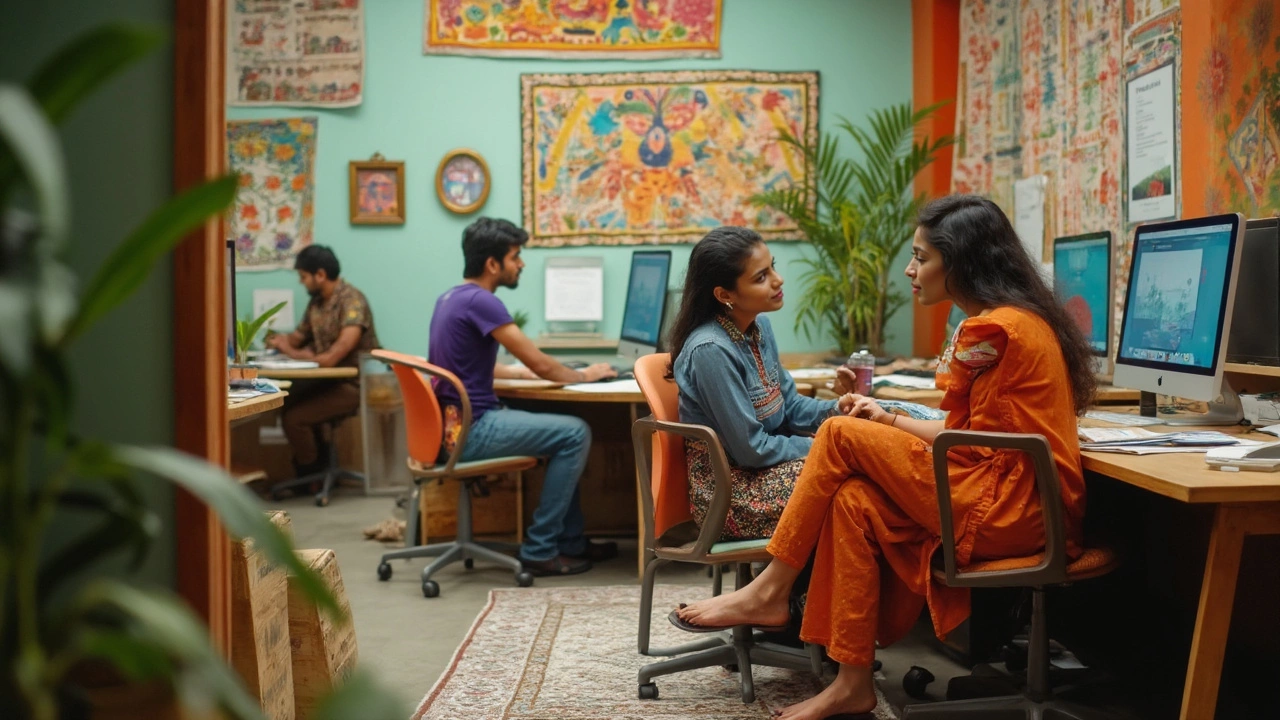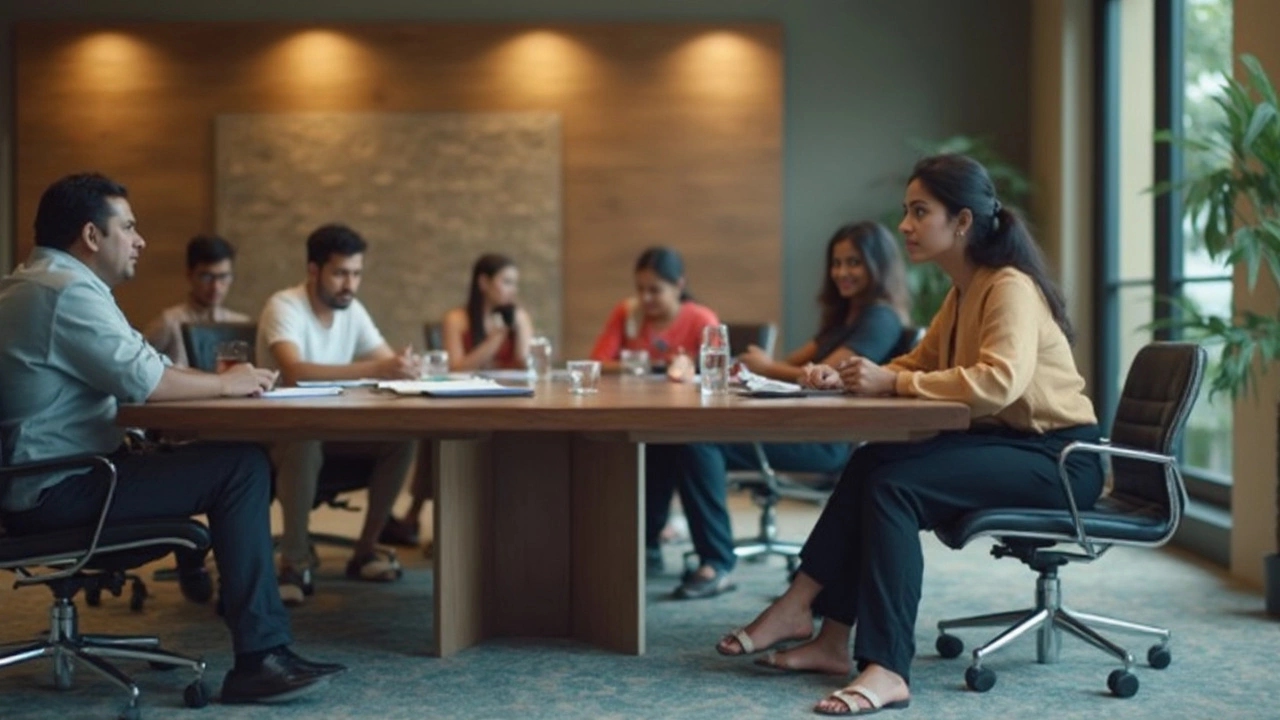Navigating the world of professional attire can sometimes feel like walking a fine line between comfort and conformity. One question that often pops up is whether it's okay to wear open-toed shoes to work. The answer isn't always black and white; it largely depends on where you work and what the unwritten rules are.
Some offices might have a laid-back vibe where open-toed shoes fit right in, especially if you're in a creative industry or work in a warm climate. But in other places, like strict corporate settings or jobs that require safety footwear, these choices might not be seen as appropriate.
The key is to read the room, so to speak. Look around your office and see what others are doing. Is there a formal dress code policy? If in doubt, you might want to err on the side of caution initially, then adjust as you get a better feel for what's considered acceptable. And remember, your shoes say a lot about you, so make sure they're sending the right message.
- Understanding Workplace Dress Codes
- When Open-Toed Shoes Might Be Okay
- Potential Pitfalls of Open-Toed Shoes
- Alternatives to Consider
- Tips for Making the Right Choice
Understanding Workplace Dress Codes
Figuring out what to wear at the office can sometimes feel more challenging than the job itself. Getting a handle on the dress code can make all the difference. It's about making sure your personal style doesn't clash with your company's culture or the expectations tied to your role.
Types of Dress Codes
There are a few different types of dress codes you're likely to encounter:
- Business Formal: This is the most strict level, where suits, ties, and closed-toe shoes are the norm. It's the dress code at many law firms or high-end financial businesses.
- Business Casual: A bit more relaxed but still professional, this includes slacks or khakis, button-down shirts, and more traditional loafers or dress shoes. Open-toed shoes might be considered depending upon specifics.
- Casual: Sometimes referred to as "smart casual," this is the most flexible, where even jeans can make the cut, and chances are, open-toed shoes might be welcome if they’re stylish and clean.
Consulting the Handbook
If your workplace has an employee handbook, that's where you'll find the dress code policy. These policies usually explain what's allowed and what's not. They're like the bibles of office attire. Reading through it can answer the “open-toed shoes or not?” question pretty quickly.
Unwritten Rules
Sometimes, the real rules are the unwritten ones. What does everyone else wear? Feel out the vibe by observing your colleagues. Pay special attention during meetings or company events. If everyone’s in fancy leather shoes, maybe keep the flip-flops at home.
Adaptation
Dress codes aren't static. They might change with new leadership, business growth, or societal trends. Stay adaptable, and you might find your work shoes evolving alongside the dress code. Open communication with your manager can also clarify what's in or out over time.
In the end, it's about blending your comfort with the professional image you aim to project at work.
When Open-Toed Shoes Might Be Okay
Open-toed shoes might seem a little breezy for some work environments, but there are situations where they actually fit perfectly, balancing style with professionalism.
Creative Workplaces
In creative industries, like marketing, design, or advertising, the dress code tends to be more relaxed. If you're in one of these fields, you might find that open-toed shoes are not only acceptable but encouraged as part of a trendier, more individualized fashion statement. Just make sure your footwear is neat and stylish—no one wants to see disheveled sandals.
Warmer Climates
Let's be honest—when the temperature soars, closed shoes can feel pretty stifling. In places with a hot climate, like Miami or LA, many offices will overlook the open-toed look for practicality's sake. It's basically a sanity saver during the sweltering summer months.
Office Dress Codes
When in Rome, dress as the Romans do, right? Always check your company’s dress code policy. If there's no specific mention of open-toed shoes, play it safe and check with HR or sneak a peek at what your coworkers are doing. Some offices might have casual Fridays or relaxed summer dress codes that allow this kind of footwear.
Job Roles
Your role at the company also plays a part. If you're in a client-facing position or expected to present a certain image, you might want to skip open-toed shoes. However, roles that don't involve much outside interaction, like certain IT positions or creative roles, might give you more fashion freedom.
| Environment | Acceptability |
|---|---|
| Creative Agency | High |
| Corporate Office | Low to Medium |
| Tech Start-Up | Medium to High |

Potential Pitfalls of Open-Toed Shoes
While open-toed shoes can be a great addition to your wardrobe, wearing them to work isn't without its challenges. Let's break down some of the reasons why they might not be the best fit for every workplace.
Professional Perception
One of the biggest issues with open-toed shoes is how they're perceived in the workplace. In more traditional or formal settings, open-toed shoes might not align with the professional image that a company wants to project. They can be seen as too casual or informal, which might not sit well with bosses or clients. It's always good to be mindful of the culture and expectations at your office.
Safety Concerns
If your job involves a lot of moving around, open-toed shoes might pose a safety risk. Whether it's working in a laboratory, a kitchen, or an active stockroom, there's a real chance of injury with something as minor as stubbing a toe or dropping something on your foot. Closed shoes often provide the necessary protection in these environments.
Hygiene Factors
Okay, let's talk hygiene. Open-toed shoes expose your feet to the elements, which isn't always great, especially if you're navigating through a workplace with shared resources. In environments where cleanliness is key—like hospitals or food services—keeping feet covered can help maintain sanitary conditions.
Weather Dependencies
Weather can also be a buzzkill for your summer footwear dreams. Those open-toed shoes might look fabulous, but if your feet are freezing in an air-conditioned office or slogging through puddles on a rainy day, they lose a bit of their charm.
Dress Code Clashes
Finally, it's important to adhere to your company's dress code. Some places have explicit rules about footwear, and open-toed shoes might be on the 'no' list. Always check your company's policies to avoid any unwanted attention.
| Workplace Setting | Open-Toed Shoes Allowed? | Reason |
|---|---|---|
| Corporate Office | No | Maintains formal appearance |
| Creative Agency | Yes | Encourages personal expression |
| Manufacturing Plant | No | Ensures safety standards |
So, before you slip into those stylish sandals, be sure to weigh the pros and cons and think about your specific work environment. It'll save you from any potential mishaps and keep your workplace experience smooth sailing.
Alternatives to Consider
Finding the right work shoes that balance comfort and professionalism can sometimes be a challenge. If open-toed shoes aren't cutting it for your office, don't sweat it. There are plenty of options out there that can keep your feet happy and your boss, too.
Closed-Toe Flats
Flats are a solid go-to when you're looking for something comfy yet polished. They're perfect for workplaces with more conservative dress codes. Whether they're sleek ballet styles or those loafers you eye each time you pass the store, they usually match well with almost any outfit. Plus, they're versatile enough to go from a business meeting to after-work drinks effortlessly.
Sneakers Done Right
But wait, aren't sneakers super casual? Not necessarily! The trick is going for those crisp, clean styles without the flashy logos. Think subtly stylish, something like leather sneakers that keep things professional but are still easy on the feet. Just make sure your office is cool with them. If they are, you’ll find sneakers surprisingly adaptable—pair them with tailored pants and you're good to go.
Classic Loafers
Loafers strike a balance between formal and comfortable, making them a fantastic alternative for open-toed shoes. These classics come in various materials like suede and leather, offering a touch of sophistication without compromising on comfort. They're a classic for a reason!
Boots with a Low Heel
When the weather permits, boots can be a lifesaver. A pair of ankle boots with a low heel can offer a professional look that's also suitable for autumn or winter days. They're sturdy, comfortable, and available in a range of designs that can suit casual Fridays to regular office days.
Experimenting Safely with Colors
Sticking to the basics in terms of styles doesn’t mean you have to play by the same rules with color. If the company culture allows, opt for shades beyond the usual black and brown. Soft pastels, navy, even a tasteful wine color can jazz up your look while still staying within the boundaries of professional attire.
So next time you’re shoe shopping, maybe skip the open toes and try something from this list. Your feet—and your HR department—will thank you for it!

Tips for Making the Right Choice
Choosing the right pair of shoes for work can sometimes be as challenging as the work itself. If you're considering open-toed shoes, here are some practical tips to help you decide.
Know Your Office Culture
Before you slip on those sandals, take a good look around your office. Are colleagues and supervisors wearing them? If open-toed shoes are common and accepted, you're probably in safe territory. On the other hand, if you're in a strict corporate setting, it's better to stick to closed-toe options.
Weather and Climate
Recognize the climate you're working in. If you're in a scorching summer heat, it might make sense to opt for something breezier. Just make sure your choice doesn't sacrifice professionalism.
Assess the Dress Code
Always refer to your company's dress code. Even if nobody else seems to follow the rules to the letter, it's good practice to know what's officially allowed. This will help you avoid any awkward conversations or wardrobe mishaps.
Consider the Occasion
While regular days might allow a bit more flexibility, important meetings or presentations often call for a more polished look. Note the occasions when eyes are more likely to fall on those feet of yours and plan accordingly.
Personal Comfort Is Key
Above all, don’t ignore comfort. Stylish shoes won't do you any good if they're causing pain by lunchtime. Make sure any shoes—whether open-toed or otherwise—support you throughout the day.
- Consider investing in quality shoes with some arch support.
- Make sure the fit is right to avoid blisters and discomfort.
- If standing a lot, opt for shoes with a cushioned sole.
Ultimately, figuring out the right work shoes is a personal affair. Knowing the rules, reading the room, and putting a foot forward confidently are your best bets for blending comfort with professionalism.

